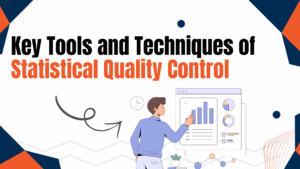In today’s competitive world, businesses cannot rely on guesswork to maintain standards. Customers expect the same quality each time, but meeting those expectations is not always easy. That’s where statistical quality control comes in. It helps companies track, measure, and improve their processes using data instead of assumptions. Because of that, teams can spot errors early, reduce waste, and deliver better products. With the right approach, organisations can achieve consistent results and earn customer trust.
What is Statistical Quality Control?
When we talk about statistical quality control, we mean using data-driven techniques to monitor and manage product or service quality. It involves applying statistics in practical ways so businesses can avoid mistakes and maintain standards. Here are the main points:
- It checks if processes are running within set limits.
- Uses statistical data analysis methods to identify trends and irregularities.
- It focuses on prevention rather than fixing problems later.
- Saves time and cost because errors are caught early.
- It builds customer confidence by ensuring reliability.
So, if an organisation applies these steps carefully, it can maintain efficiency and deliver consistent outcomes.
Key Tools and Techniques of Statistical Quality Control

Several proven methods make statistical quality control successful. Each of them helps in spotting issues and improving performance. Some important tools and techniques include:
- Control Charts: These track variations in production and highlight when results go out of range. They are one of the oldest yet most effective research data analysis tools.
- Histograms: These show data in a simple chart, making it easy to identify patterns.
- Pareto Analysis: This technique follows the 80/20 rule, helping teams focus on the key causes of problems.
- Cause-and-Effect Diagrams: Also known as fishbone diagrams, they help identify root causes.
- Scatter Diagrams: These reveal relationships between two variables, which is important for improving accuracy.
- Sampling: Instead of checking every item, businesses can analyse a sample to save time.
Because of these tools, businesses can clearly understand where issues occur and how to correct them.
How to Master Statistical Quality Control?

Learning and applying statistical quality control requires structured steps. It is not enough to know the tools; one must also use them effectively. Here’s how organisations and individuals can master it:
- Get Proper Training: Teams should take part in quantitative data analysis training programs. This helps them understand how to apply data in real-world cases.
- Use the Right Tools: Choose the best methods for the problem, whether it’s control charts, histograms, or sampling.
- Collect Accurate Data: If the data is wrong, the results will be wrong too. So, ensure the data collected is complete and reliable.
- Analyse and Interpret: Don’t just collect numbers; analyse them with care. This helps identify true causes of variation.
- Improve Continuously: Statistical quality control is not a one-time job. It must be part of everyday work.
By following these steps, organisations can make quality a long-term strength.
Dos and Don’ts for Better Results
If you want to apply statistical quality control effectively, you must know the best practices and the mistakes to avoid. Let’s look at some dos and don’ts:
Dos
- Data visualisation training should be used to help teams understand complex information easily.
- Check processes regularly to ensure results stay consistent.
- All team members should be involved so quality control becomes a shared responsibility.
Don’ts
- Don’t rely only on guesswork; always back decisions with data.
- Don’t ignore small problems because they can grow bigger later.
- Don’t skip proper documentation, as records help in future improvements.
So, if you follow these rules, your results will improve, and your process will stay strong.
Benefits of Applying Statistical Quality Control
When businesses adopt statistical quality control, they unlock many advantages that go beyond cost savings. At Resilient Foundation, we believe in empowering organisations with the right knowledge and tools for growth. Here are some clear benefits:
- Higher Consistency: Processes run smoothly, and products maintain the same level of quality.
- Lower Costs: Early error detection reduces waste and rework, saving resources.
- Better Decision-Making: By using cluster analysis, businesses can group data and find hidden insights.
- Employee Growth: With training in data-based methods, employees become more confident and skilled.
- Customer Trust: When products meet standards every time, customer loyalty grows.
- Future-Ready Skills: At Resilient Foundation, we offer sessions on quantitative data analysis training and data visualisation training to prepare teams for tomorrow’s challenges.
Because of that, organisations that adopt these practices gain a clear competitive edge. Resilient Foundation supports this journey by providing expertise, training, and tools that turn data into meaningful action.

